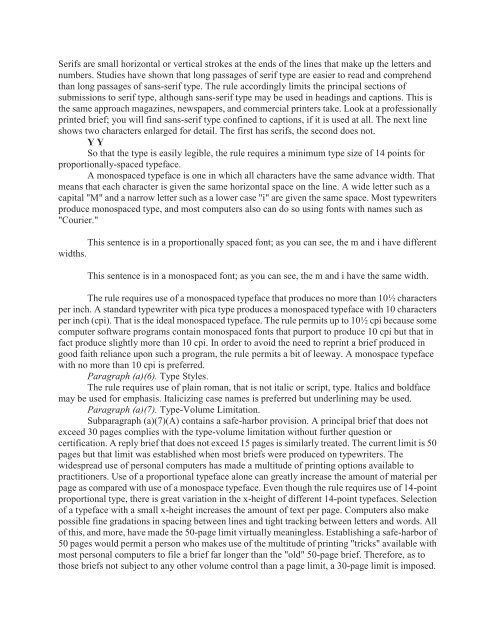Federal Rules of Appellate Procedure 2014-2015, 2014a
Federal Rules of Appellate Procedure 2014-2015, 2014a
Federal Rules of Appellate Procedure 2014-2015, 2014a
Create successful ePaper yourself
Turn your PDF publications into a flip-book with our unique Google optimized e-Paper software.
Serifs are small horizontal or vertical strokes at the ends <strong>of</strong> the lines that make up the letters and<br />
numbers. Studies have shown that long passages <strong>of</strong> serif type are easier to read and comprehend<br />
than long passages <strong>of</strong> sans-serif type. The rule accordingly limits the principal sections <strong>of</strong><br />
submissions to serif type, although sans-serif type may be used in headings and captions. This is<br />
the same approach magazines, newspapers, and commercial printers take. Look at a pr<strong>of</strong>essionally<br />
printed brief; you will find sans-serif type confined to captions, if it is used at all. The next line<br />
shows two characters enlarged for detail. The first has serifs, the second does not.<br />
Y Y<br />
So that the type is easily legible, the rule requires a minimum type size <strong>of</strong> 14 points for<br />
proportionally-spaced typeface.<br />
A monospaced typeface is one in which all characters have the same advance width. That<br />
means that each character is given the same horizontal space on the line. A wide letter such as a<br />
capital "M" and a narrow letter such as a lower case "i" are given the same space. Most typewriters<br />
produce monospaced type, and most computers also can do so using fonts with names such as<br />
"Courier."<br />
This sentence is in a proportionally spaced font; as you can see, the m and i have different<br />
widths.<br />
This sentence is in a monospaced font; as you can see, the m and i have the same width.<br />
The rule requires use <strong>of</strong> a monospaced typeface that produces no more than 10½ characters<br />
per inch. A standard typewriter with pica type produces a monospaced typeface with 10 characters<br />
per inch (cpi). That is the ideal monospaced typeface. The rule permits up to 10½ cpi because some<br />
computer s<strong>of</strong>tware programs contain monospaced fonts that purport to produce 10 cpi but that in<br />
fact produce slightly more than 10 cpi. In order to avoid the need to reprint a brief produced in<br />
good faith reliance upon such a program, the rule permits a bit <strong>of</strong> leeway. A monospace typeface<br />
with no more than 10 cpi is preferred.<br />
Paragraph (a)(6). Type Styles.<br />
The rule requires use <strong>of</strong> plain roman, that is not italic or script, type. Italics and boldface<br />
may be used for emphasis. Italicizing case names is preferred but underlining may be used.<br />
Paragraph (a)(7). Type-Volume Limitation.<br />
Subparagraph (a)(7)(A) contains a safe-harbor provision. A principal brief that does not<br />
exceed 30 pages complies with the type-volume limitation without further question or<br />
certification. A reply brief that does not exceed 15 pages is similarly treated. The current limit is 50<br />
pages but that limit was established when most briefs were produced on typewriters. The<br />
widespread use <strong>of</strong> personal computers has made a multitude <strong>of</strong> printing options available to<br />
practitioners. Use <strong>of</strong> a proportional typeface alone can greatly increase the amount <strong>of</strong> material per<br />
page as compared with use <strong>of</strong> a monospace typeface. Even though the rule requires use <strong>of</strong> 14-point<br />
proportional type, there is great variation in the x-height <strong>of</strong> different 14-point typefaces. Selection<br />
<strong>of</strong> a typeface with a small x-height increases the amount <strong>of</strong> text per page. Computers also make<br />
possible fine gradations in spacing between lines and tight tracking between letters and words. All<br />
<strong>of</strong> this, and more, have made the 50-page limit virtually meaningless. Establishing a safe-harbor <strong>of</strong><br />
50 pages would permit a person who makes use <strong>of</strong> the multitude <strong>of</strong> printing "tricks" available with<br />
most personal computers to file a brief far longer than the "old" 50-page brief. Therefore, as to<br />
those briefs not subject to any other volume control than a page limit, a 30-page limit is imposed.


















